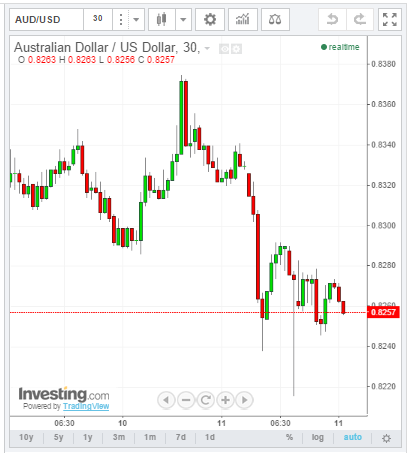Last might the Aussie fell within a whisker of the 81s at $82.12 before rebounding to the mid 82s:

The reason was a combined jawboning assault from Capt’ Glenn and Mr Rainbow, finally coordinating a message after flouncing around for years with their own opinions. First, the Captain at the AFR:
AFR: When we spoke at this time last year, the Australian dollar was around US90¢ and you suggested you would like to see it closer to US85¢. That took quite a while but now it’s down to US82¢, US83¢. You’ve just strengthened your language, though, on the dollar saying that it still needs to fall further. What sort of level do you think it does need to fall to to achieve balanced growth?
MR STEVENS: Well, I think it’s quite likely that it will a year from now be lower than it is today, on the basis of the facts that we presently have. And, yes, a year ago I said probably 85US cents was better than 95. And if I had to pick a figure now, I would say probably 75 is better than 85.
AFR: And even when the Australian dollar has fallen against the US dollar, on a trade-weighted basis it’s probably about where it was, maybe a touch lower than a year ago.
MR STEVENS: Not much has occurred. I think that’s right. So the thing we are mostly seeing is the US dollar being re-rated against most other currencies. That’s logical given the state of the US economy, given that it seems pretty clear, at this point, that it will be the first to begin the normalisation of interest rates before the other major jurisdictions. You would expect the US dollar to reflect that and, really, in a way the puzzle was why that didn’t happen a bit sooner. So much of it is – as you say – a re-rating of the US dollar. There’s probably a little bit more adjustment of the Aussie dollar against some of the others just lately than there had been. But, as I say, I think given that the terms of trade are doing what they’re doing, even though they’re still historically high, my guess is the likelihood is that the Australian dollar will probably adjust further yet before this is over.
AFR: And is that true across the basket of currencies in the trade-weighted index?
MR STEVENS: Well, I’m not going to make you a price for all the cross rates. But you would think that, on a trade effective basis, it will probably decline somewhat.
AFR: Even with the headwinds coming from quantitative easing in Japan and Europe?
MR STEVENS: I think on an effective trade-weighted overall basis – without wanting to pick out which ones, you know, might look different – you would expect it to come down somewhat further. And I think the market is starting to behave more consistently with that view now.
AFR: Do you think that the dollar market now is looking as much at our terms of trade as it is at US dollar strength? Is that where we’re going now?
MR STEVENS: Well, who can say what’s in the minds of the myriad people that are responsible for what is an $80 billion or $100 billion-a-day turnover? Who can say? But I think the adjustment we have been seeing is taking us closer to where most fundamental metrics would have you be. But I doubt that adjustment is yet complete. That’s really what I’m saying.
AFR: So it’s not yet at the stage where it would be assisting the economy in the way that you would expect it to be given what has happened to the terms of trade?
MR STEVENS: Well, it’s doing more of its job than it was doing. But I suspect it may do more.
AFR: So coming from US90¢ to US75¢, how much of a stimulus do you think that would provide to the overall economy?
MR STEVENS: Well, it depends what else is happening. That’s the point. The exchange rate responds to the various fundamental forces. And we’ve just been discussing the terms of trade and so on, that they’re adjusting as well. So this is in some sense a bit of a moving target. And you can’t really assess the amount of stimulus or otherwise independently of that. Longer-term, we’ve come from US$1.05 to now US82¢ and that was a very elevated level, very unusual. Surely unsustainable and it hasn’t been sustained. And some further adjustment is going to have us much more like normal historical levels, at least against the US dollar and maybe some of the others. But I think that process is not yet complete. It has a bit further to go. And the exchange rate, if that occurs, will be doing what we have customarily been able to expect and it will be doing what it should be doing.
And from Mr Rainbow at the WSJ:
AUSTRALIA’S economy will not grow strongly enough next year to prevent a further rise in unemployment, and this will require interest rates to remain low, according to John Edwards, a board member of the Reserve Bank.
Mr Edwards said the underlying momentum of the economy had not changed much this year.
“There is no doubt we are in a low-growth environment,” he said.
“It’s not enough to create jobs at a sufficiently fast rate to prevent a rise in unemployment.”
If you dig into the interviews there are still loads of contradictions, including Stevens looking determined to not cut interest rates, but the two boffins managed a consistent enough message for one night.

